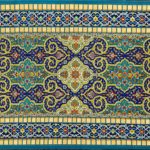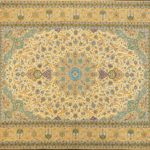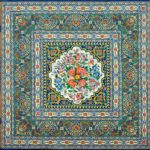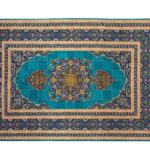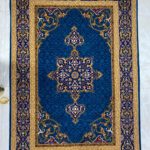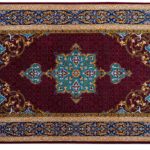Works of Alireza Safdarzadeh Haghighi
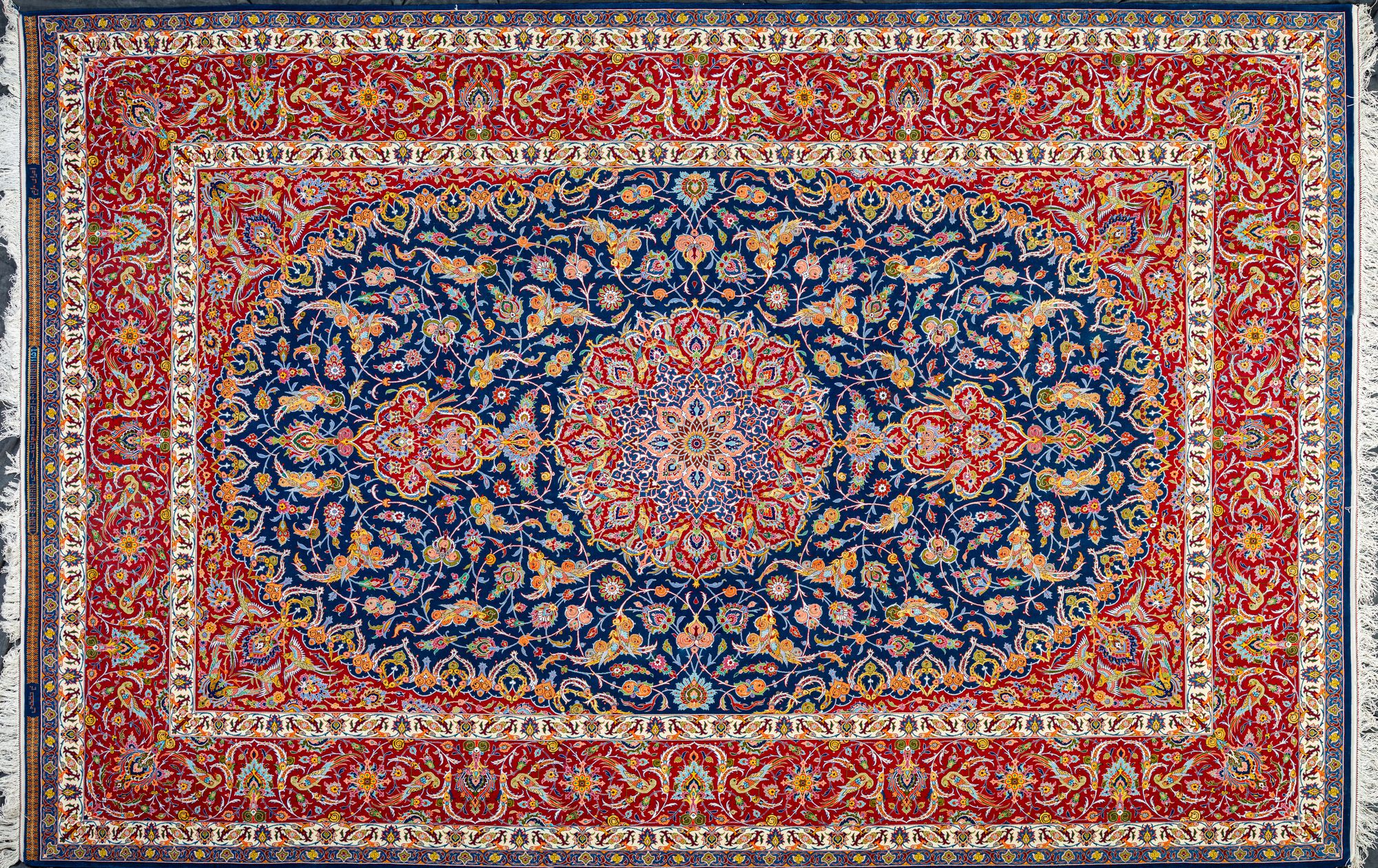
The Fish Arabesque Carpet
The carpet Fish Arabesque was designed by Rostam Shirazi and coloured with an elegant palette by Alireza Safdarzadeh Haghighi. the exquisite asymmetrical-knot carpet Measuring 381 by 249 cm, it was woven by Masoumeh Eghdami, one of Isfahan’s renowned carpet weavers, with silk warp and cotton weft. Fish Arabesque is a lachak–toranj-style carpet with a navy-blue background and uses yarns dyed with plant-derived colourants. Widely popular and frequently used for different types of carpets, the lachak–toranj is a Persian carpet design style composed of a round or oval medallion—toranj—in the centre, surrounded by four roughly triangular corner sections—lachaks. The toranj in Fish Arabesque has a red outer and a blue inner base, while the base of the “toranj-heads”—the two smaller elements shooting lengthwise of a carpet from its toranj—wide border, and lachaks is red. According to Alireza Haghighi, the carpet’s colourist, the redness of the toranj and toranj-heads evokes the brightness of the sun and represents human wisdom and insight. The carpet is decorated with fish-shaped arabesques harmoniously arranged alongside khataee designs that bear “Shah Abbas” and star flowers, leaves, and buds. The navy blue background behind the decorations recalls water and, by extension, the Persian goddess of “the Waters,” Anahita. The thick border in Fish Arabesque is four times wider than each thin border, and the ratio of the width of the thick border to that of the three thin borders combined would be 4 to 3—which add up to seven. The decision to hide this number in the carpet results from the designer Rostam Shirazi’s thorough knowledge of the history of religion as well as Persian language and literature. Seven is a significant number in the culture of the “Iranian world” and in Islam. In Zoroastrianism, the six Amesha Spenta archangels—Vohu Manah, Asha Vahishta, Khshathra Vairya, Spenta Armaiti, Haurvatat, and Ameretat—are led by Ahura Mazda, with whom they become a fellowship of seven. As part of the Islamic pilgrimage of hajj, Muslims circumambulate the Kaaba seven times, throw seven pebbles at the walls (formerly pillars) that symbolize Satan, and walk back and forth between the hillocks Safa and Marwa seven times. In Ferdowsi’s Shahnameh, Rostam and Esfandiyar must complete the Seven Labours to save the life of Kay Kavus, the king of Iran, who is held captive by the White Div. Finally, Attar of Nishapur argues through his The Conference of the Birds that a Sufi must travel the Seven Cities of Love (the Seven Valleys) before he can attain spiritual enlightenment. Rostam Shirazi’s masterful design and Alireza Safdarzadeh Haghighi’s inimitable colouring has made Fish Arabesque a fine specimen of the Isfahan tradition of Persian carpet. Negin Al-sadat Tabatabaei Islamic Archaeology PhD graduate, University of Tehran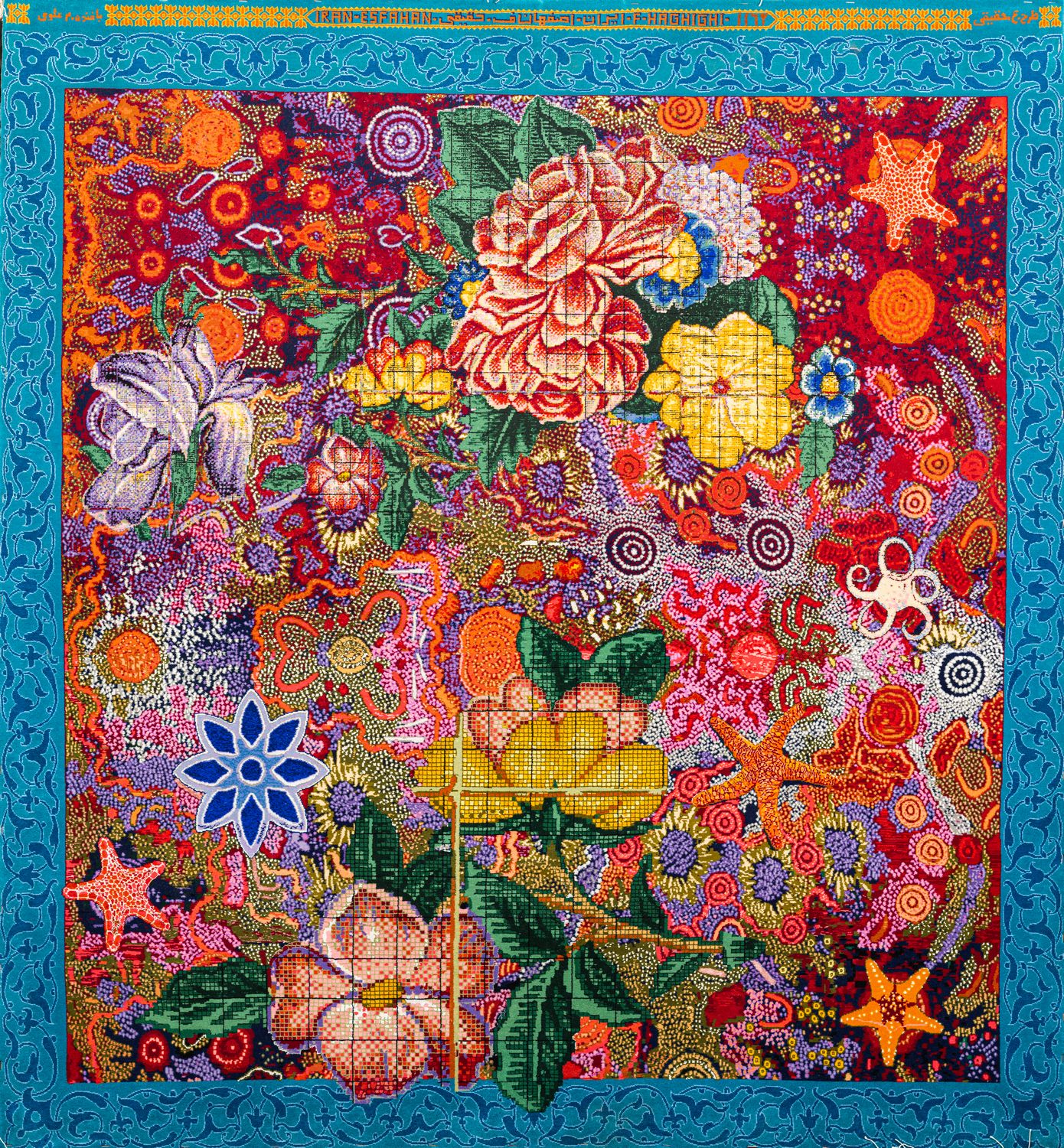
Flower Garden and the Sea
Measuring 155 by 145 cm, Flower Garden and the Sea is an asymmetrical-knot pictorial carpet (tableau rug) designed by Alireza Safdarzadeh Haghighi and woven in 2020 by Masoumeh Alavi with silk warp and cotton weft.By creating the uniquely designed Flower Garden and the Sea, Alireza Haghighi wanted to show some of the less-explored sides of the art of carpet-making, especially those related to human nature, ethics, and spirituality. Coloured with a generous palette of 150 plant-derived colourants, Flower Garden and the Sea is the world’s first carpet to incorporate into its design the graph paper grids that aid a carpet’s design process and the carpet plan pixels that guide a weaver. This tactic, together with the colour scheme, allows the work to be recognized as belonging to the Isfahan tradition of Persian carpet.
Another design innovation in this tableau rug is the placement of the toranj—or in this case, the toranjes. Although the shape of the starfish qualifies them to serve as the toranj, none of them is given the centre spot. By arranging them this way, Haghighi is proposing the idea that a toranj can sit anywhere in a carpet and have a prominent presence without being necessarily in the centre.
The elements in Flower Garden and the Sea are placed in different layers with seemingly varying distances from the viewer, creating an illusion of depth. The nearest layer represents the ground by containing the flowers, while the farther layers bear the starfish, corals, and other sea-related things. The only man-made object in the picture is the blue eight-pointed star in the bottom right quarter. The star, as used here, communicates the idea that man’s presence in the world will be harmless and fruitful so long as it is in harmony with nature; that if man goes against nature—a behaviour that doubled in scale and speed with the Industrial Revolution and even more so with the dawn of the 20th century—he will become an incongruous creature who is incompatible with everything in the universe, a creature whose actions will ultimately even unravel his achievements. The eight-pointed star used by Haghighi has been a frequent motif in Iranian art and Islamic architecture, mostly used in the ornament of places such as building entrances and the mihrab of mosques and imamzada shrines. The earliest known use of the star, albeit in its more simplified form, is on a coin of Orodes II, who ruled over Iran from 54 BC to 36 BC as the 13th king of the Parthian Empire. Eight- and six-pointed stars also make an appearance on the mihrab of the Jameh Mosque of Farumad and the Jameh Mosque of Natanz.
Through Flower Garden and the Sea, Alireza Haghighi makes a moral and social point and introduces us to the spiritual side of the art of carpet design and weaving. Negin Al-sadat Tabatabaei
Islamic Archaeology PhD graduate, University of Tehran


